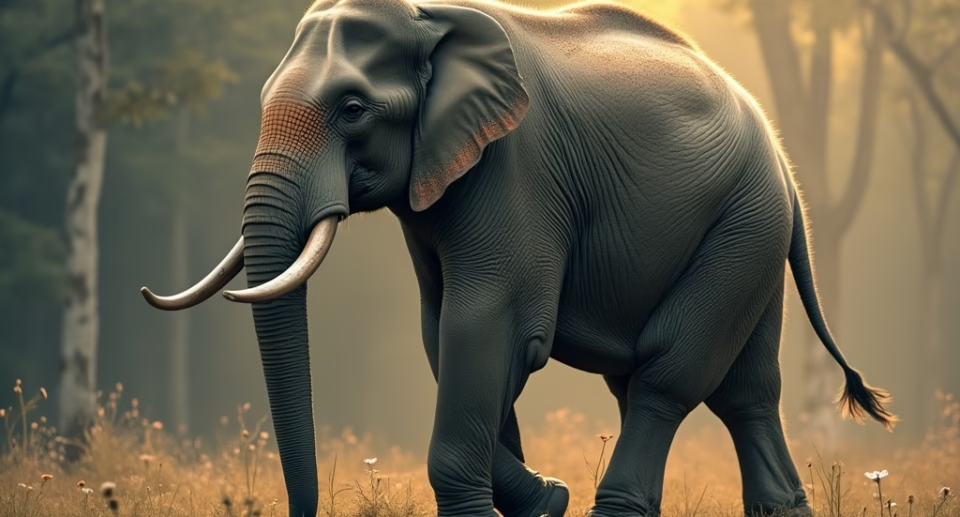Asian-elephant spiritual meaning

Asian elephants have held a profound spiritual significance across numerous Asian civilizations for thousands of years, representing divine wisdom, strength, and cosmic order in religious traditions from Hinduism to Buddhism. These magnificent creatures transcend mere animal status, embodying sacred principles that have shaped cultural practices, religious ceremonies, and spiritual beliefs throughout the continent’s diverse societies.
Key Takeaways
- The Asian elephant serves as a physical manifestation of divine wisdom in multiple religious traditions
- Lord Ganesh, the elephant-headed deity, represents one of Hinduism’s most beloved deities
- Elephants hold official status as national symbols in Thailand and Laos, reflecting their cultural importance
- The matriarchal structure of elephant societies symbolizes family unity and maternal leadership
- Modern conservation efforts increasingly draw from traditional spiritual values to protect these sacred animals
The Divine Elephant in Religious Traditions
The spiritual significance of Asian elephants reaches its pinnacle in Hinduism through Lord Ganesh, the beloved elephant-headed deity who removes obstacles and embodies divine wisdom. As one of the most widely worshipped deities in the Hindu pantheon, Ganesh represents the perfect fusion of human and elephant qualities—combining human compassion with elephantine wisdom, strength, and memory.
In Buddhist tradition, elephants hold equal reverence, with Gautama Buddha said to have entered his mother’s womb in the form of a white elephant, symbolizing purity and spiritual power. This divine connection appears throughout Buddhist artwork and literature, where elephants often represent mindfulness, strength, and mental fortitude.
Temple elephants continue this sacred tradition today, participating in religious ceremonies across India, Thailand, and Sri Lanka. These specially trained elephants aren’t merely performers but considered living embodiments of divine energy, blessing devotees during festivals and processions. Their perceived emotional intelligence and ancestral memory further cement their status as spiritually evolved beings capable of connecting with divine realms.
Cultural Embodiment: National Symbols and Heritage
The spiritual reverence for elephants extends beyond religious contexts into national identity throughout Asia. Thailand has officially designated the white elephant as its national animal, with these rare creatures historically considered the property of the king. Similarly, Laos features the elephant prominently in its cultural heritage, earning the historical title “Land of a Million Elephants.”
India formally recognizes the elephant as its national heritage animal, reflecting its deep integration into the country’s spiritual and cultural traditions. Ancient Indian texts like the Arthashastra and Gajashastra contain detailed instructions on elephant care, training, and their role in royal and religious contexts, demonstrating the profound respect afforded to these animals throughout Indian history.
Asian elephants also feature prominently in zodiac systems across multiple cultures. In Thai astrology, being born in the Year of the Elephant connects individuals with qualities of wisdom and strength. The elephant’s appearance in classical literature further cements its cultural prominence, with moral lessons in the Panchatantra and Jataka tales often delivered through elephant characters who exemplify wisdom, patience, and moral virtue.
Symbols of Fortune and Prosperity
Beyond religious significance, elephants are widely regarded as harbingers of good fortune across Asian cultures. In Chinese Dai minority traditions, encountering an elephant is considered an exceptionally lucky omen, with some communities practicing food offerings to attract elephants and their associated prosperity.
The matriarchal structure of elephant societies has special resonance in many Asian spiritual traditions. Female elephants leading family groups symbolize maternal wisdom and family unity—values highly prized throughout the continent. This natural leadership structure has inspired human social organizations and reinforced the elephant’s status as a model of ideal social harmony.
Historically, ivory carried significant prosperity symbolism in Asian cultures, though modern ethical considerations have largely transformed these traditions. Contemporary spiritual practices now focus on the living elephant rather than its tusks, emphasizing the sustainable connection between humans and these sacred animals. Many communities now create replicas from sustainable materials to maintain traditional practices without harming elephants.
Conservation Challenges in Sacred Lands
Despite their spiritual significance, Asian elephants face severe threats in their native habitats, creating a profound contradiction between reverence and reality. Human-elephant conflict intensifies as expanding human populations encroach on traditional elephant territories, forcing these sacred animals into increasingly hostile environments.
Deforestation presents perhaps the greatest threat, destroying not only physical habitats but also the sacred landscapes where spiritual connections between humans and elephants have flourished for millennia. When forests disappear, so do the settings for traditional ceremonies and encounters that maintain cultural reverence for elephants.
Poaching continues despite religious prohibitions against harming elephants, driven by international demand for ivory and other elephant parts. This crisis reveals the gap between traditional values and modern economic pressures. Encouragingly, community-based conservation models increasingly draw from spiritual traditions to motivate protection efforts, reconnecting economic incentives with deep-rooted cultural values.
Modern Spiritual Coexistence
Ethical tourism represents one path toward harmonizing spiritual reverence with practical conservation. Sanctuaries throughout Thailand, India, and Sri Lanka now combine traditional spiritual education with modern conservation practices, allowing visitors to appreciate elephants in respectful settings that honor their sacred status.
Many communities are reviving traditional ceremonies celebrating the elephant-human bond, adjusting ancient practices to eliminate harmful elements while preserving core spiritual meanings. These ceremonies help maintain cultural connections while educating younger generations about conservation ethics.
The contrast between Asian and African elephant symbolism reveals interesting cultural patterns. While Asian traditions tend to emphasize wisdom, divinity, and cosmic order, African traditions often focus on the elephant’s role as a powerful ancestor figure and symbol of natural leadership. These different spiritual approaches reflect unique cultural contexts while sharing a fundamental reverence for the elephant’s extraordinary presence.
Preserving the Sacred Connection
The Asian elephant’s spiritual significance transcends individual religious traditions, representing a shared cultural heritage across the continent. From Hindu temples to Buddhist monasteries, from Thai royal ceremonies to Indian village festivals, these magnificent animals continue to embody divine wisdom in contemporary Asian spirituality.
Honoring this spiritual heritage increasingly means taking concrete action to ensure elephant survival. Conservation efforts grounded in traditional values have proven especially effective, as they speak to deeply held beliefs rather than imposing external values. When local communities reconnect conservation with spiritual significance, both elephants and human cultural traditions benefit.
The endurance of elephant symbolism across millennia testifies to these animals’ extraordinary impact on human spiritual imagination. As we face modern challenges to their survival, the ancient wisdom that recognized elephants as sacred beings may provide our best guide for ensuring their future—and maintaining our spiritual connection to these remarkable creatures.
Asian elephants hold profound spiritual significance across Asian civilizations, representing divine wisdom, strength, and cosmic order in numerous religious traditions. They’re revered in Hinduism through Lord Ganesh, the beloved elephant-headed deity who removes obstacles. In Buddhism, elephants symbolize purity and spiritual power, with Gautama Buddha entering his mother’s womb as a white elephant. These magnificent creatures serve as national symbols in Thailand and Laos while participating in religious ceremonies as living embodiments of divine energy. Despite their sacred status, they face threats from habitat loss and poaching, creating a tension between reverence and reality. Modern conservation efforts increasingly draw from traditional spiritual values to protect these sacred animals.
| Key Points | Significance |
|---|---|
| Divine Representation | Lord Ganesh in Hinduism; Buddha’s incarnation in Buddhism |
| National Identity | Official symbols in Thailand and Laos; heritage animal in India |
| Family Structure | Matriarchal societies symbolizing maternal wisdom and unity |
| Conservation Challenges | Habitat loss and poaching despite religious prohibitions |
| Modern Preservation | Ethical tourism and community-based conservation rooted in spiritual values |















1 Comment
You made a number of good points there. I did a search on the topic and found nearly all folks will agree with your blog.